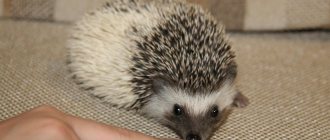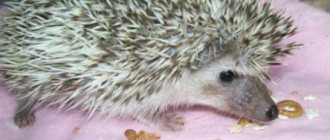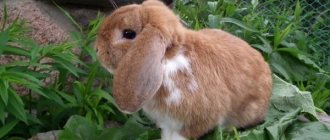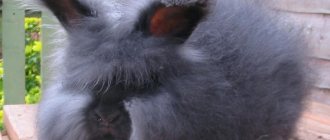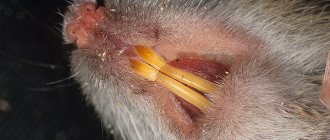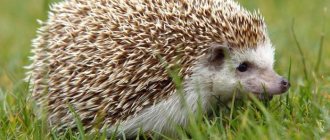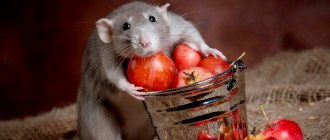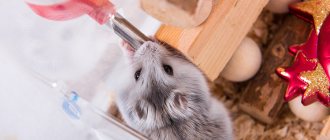- Wild animals
- >>
- Mammals
The African pygmy hedgehog is a chordate mammal. Translated from Greek it means “snake eater”. Recently, it has become fashionable to keep small rodents and other wild animals at home. Small in size and easy to care for, African pygmy hedgehogs have become full-fledged owners of many city apartments. Therefore, it is better to learn more about what kind of animals they are, how they should be treated, what to feed and how to care for them.
Origin of the species and description
Photo: African pygmy hedgehog
The origin of such a unique animal as the African pygmy hedgehog is unknown. It is believed that the animal was the result of the work of European breeders, who obtained a new breed of hedgehogs at the end of the last century.
The African pygmy hedgehog is a hybrid breed bred specifically for ease of keeping at home. Beautiful and cute, the small animal has a friendly character, it is very easy to keep in captivity, it does not hibernate like a regular hedgehog. The animal can eat special food. And if you add homemade meat waste to the diet, you can provide a completely balanced diet and a happy life for your pet.
Video: African pygmy hedgehog
These cute animals created a real stir in European and domestic pet markets. Many nurseries have appeared for breeding dwarf hedgehogs, especially since they are unpretentious and very cute animals.
The natural habitat of pygmy hedgehogs is African countries: Ethiopia, Mauritania, Zambia, Senegal, Tanzania, etc. These animals are heat-loving, unpretentious and very active. They have the ability to move well in mountainous areas and climb stones or rocks. The animal can easily climb a cliff up to 1.5 km high, reaching the top of a cliff or steep cliff, where you can usually find bird nests and feast on eggs.
Diseases
Usually, at home, hedgehogs can get injured at home, so the owner must closely monitor his pet, which he lets out for a walk around the apartment.
If the temperature regime is not observed or there are drafts, the hedgehog may catch a cold.
If you eat improperly, problems associated with the gastrointestinal tract may develop: constipation, diarrhea, bloating. With a lack of vitamins, vitamin deficiency may develop.
Hedgehogs may have parasites: ticks, fleas, worms; an experienced veterinarian can tell you how to deal with them. Allergic reactions to cleaning products, food, and even cage litter are possible. Hedgehogs and even African hedgehogs are carriers of rabies. But a hedgehog can only become infected with rabies through interaction with another infected animal.
Appearance and features
Photo: Animal African pygmy hedgehog
The African hedgehog has the appearance of an ordinary European hedgehog, only in a smaller version. A cute long muzzle and large black eyes are trimmed with fluffy soft and light fur. The same short fur is also found on the tummy. The short ears are brown and stand out well against the main light background.
The small oval body of the dwarf animal measures up to 25 cm and has a small tail. The back, sides and head of the hedgehog are covered with short black and white or sandy spines. Males are small, hedgehogs are slightly larger. The animal has short front legs with five toes. The hind legs are four-toed. The middle fingers are very long, which makes it easy to clean their needles. Sharp claws are capable of firmly holding small prey. The front fangs are very sharp and easily penetrate the body of a small rodent, lizard or snake.
The weight of an adult reaches up to 500 - 700 grams. The African hedgehog lives no more than 3-4 years; in captivity it can live up to 7-8 years. The animal can have different colors. There are dark species with small light stripes. In the natural habitat there may be brown, brownish or sandy tones. There are spotted individuals that can easily hide in thickets of grass or windbreaks.
Recently, breeders have bred several decorative breeds of dwarf hedgehogs with different interesting colors. You can find chocolate, white or black and white needles. There is even a cinnamon color that can only be seen in artificial habitats. The more original the color can be obtained, the higher the specimen is valued on the market.
What foods should I give?
Hedgehogs living in their natural environment obtain earthworms, mosquito larvae, dragonflies, and chafers.
All of this food can be purchased at a pet store, but many animal lovers raise worms and larvae at home. In separate terrariums they contain Zofobas, bloodworms, Uzbek or Madagascar cockroaches.
It is recommended to give insects not only to adults, but also to small hedgehogs. Adult animals receive worms, cockroaches and beetles in live or immobilized form. The young insects are dried, ground into powder and added to food.
Forest hedgehogs can destroy bird nests that are on the ground. They eat eggs and chicks. Beginners in zoology are interested in what hedgehogs eat when kept at home.
Pets can also be given eggs. An animal can drink 1 quail egg per day. It is recommended to boil chicken eggs. You can give ¼ teaspoon of the product per day.
In order not to kill the chicks, pets can be fed beef, horse meat or chicken. Meat can be introduced into the diet in the form of minced meat or cut into small pieces. Breeders recommend boiling the meat.
You can give boiled liver. This product is mixed with porridge or vegetables. Pork is contraindicated. For a domestic hedgehog and a forest animal, such food is heavy and unusual.
Fish is good for pets. They boil it and remove all the bones. It should always be freshly prepared. It is allowed to include river and sea fish into the diet, but only once a week.
Using this product too frequently may cause stunted growth and discoloration of the needles.
For hedgehogs, crumbly porridge is prepared. Use wheat or oats. You can give grains in sprouted form. No spices or milk are added to porridge. Hedgehogs love bread, but give them this product in the form of crackers. Fresh bread increases gas formation in the intestines.
Forest animals eat grass and berries. They can climb into summer cottages and eat sweet apples and pears. Hedgehogs at home are given vegetables, fruits, and berries in their diet.
For your pet, you can bring leaves and flowers of dandelion, plantain, and clover. You can make preparations for the winter, dry grass, berries or fruits.
Breeders offer a list of foods that should not be given to pet hedgehogs. In addition to milk, the following foods are contraindicated for animals:
- canned food: meat, fish, vegetables, jam;
- dog and cat food;
- exotic fruits: orange, pineapple, avocado;
- sausages;
- chips, cookies, fresh baked goods;
- spicy foods with salt, pepper, vinegar, garlic;
- candies, chocolate and other sweets;
- dumplings;
- fast food;
- products that contain unnatural additives, dyes;
- nuts, seeds.
Animals are given regular, filtered, unboiled water. Nipple drinkers are installed in the cages. The water should be warm, room temperature. It is changed daily.
Loading …
Where does the African pygmy hedgehog live?
Photo: African pygmy hedgehog at home
The natural habitat of African hedgehogs is arid deserts, steppes, and tropics. All varieties prefer plateaus overgrown with low bushes and rocky screes; they do not like dense forest thickets.
In African deserts and arid steppes, animals find a lot of food for themselves and their offspring, which is easy to catch in open areas.
Pregnancy
Determining that a female is pregnant is difficult. Its body is covered with a shell with thick spines. They hide the completeness of the individual. Hedgehogs have enlarged sides, but this may be due to increased nutrition. Often members of the household find out that the female will have a new baby when a squeak is heard in the house.
Loading …
It is not recommended to palpate the belly; it can damage the cubs. The hedgehog may become calmer, more sedate, and stops running when walked.
After a week-long meeting with the male, the female is prescribed a high-calorie diet. Vitamins and calcium must be added to it. A hedgehog needs a lot of nutrients for the normal development of pregnancy and for the growth of cubs. Calories are reduced when the lactation period ends:
- the female is given insects;
- chicken is replaced with hearts and liver;
- all products are well boiled;
- insects must be safe;
- It is better to give boiled chicken eggs;
- The hedgehog is given sprouted wheat and oats, vegetables, fruits, berries;
- of vitamins, “Fitocalcevit” is administered for dogs; on the tip of a knife, add to the meat.
Pregnancy lasts 31 days, but the birth of a new baby is expected until the 35th day. During this period, the running wheel and high mazes are removed from the cage.
They install a larger house so that it can comfortably accommodate a mother and her offspring. In order for her to create a cozy nest, clean rags, paper napkins, and soft hay are placed in the cage.
What does the African pygmy hedgehog eat?
Photo: Domestic hedgehog
The African pygmy hedgehog is an omnivore and a very voracious animal. During the night he can consume a large amount of food, which reaches up to a third of his weight. Its food is various small insects and all invertebrates, including earthworms, snails, slugs, etc. At home, hedgehogs are fed with special food.
In the wild, all hedgehogs love to feed on bird eggs, chicks left unattended, and do not disdain reptiles and even carrion, performing an important function as territory orderlies. Animals love to eat mushrooms, seeds and roots of plants or herbs.
Small but brave hedgehogs are able to resist snakes or poisonous scorpions, defeating them with the help of their evasiveness and sharp teeth.
How to choose a place for a cage
The African hedgehog is a nocturnal animal and its peak activity occurs at this time of day. To ensure that it does not interfere with your rest, you should find a place for the cage that will be located at a sufficient distance from the bedroom.
Before you bring a hedgehog into your home, you should decide in advance where his house will be located. The place must be comfortable, otherwise the animal may get sick and even die.
It is strictly not recommended to place the cage on a windowsill. Direct rays of the sun are harmful, as the hedgehog can get heatstroke. In the cold season, in the presence of drafts, colds occur if the windows are not airtight.
Features of character and lifestyle
Photo: African pygmy hedgehog
The African pygmy hedgehog is highly active and loud. He can snort cheerfully and growl if a stranger suddenly encroaches on his separate territory. When a hedgehog is injured and in severe pain, it can squeal very loudly, notifying the entire neighborhood about its problem. An interesting fact is that during a fierce battle with an enemy, a hedgehog chirps like a big bird, confusing its enemy and terrifying him with incomprehensible sounds.
Hedgehogs are very active at night, when they hunt for small insects or rodents. The animal lives in a hole dug between boulders or under a heap of old branches. May take over someone else's burrow left by a rodent or other animal. In the summer, hedgehogs hibernate, which lasts until autumn.
At home, pygmy hedgehogs can be kept in cages or aquariums, or you can let them walk around the apartment. But you definitely need to create an artificial burrow from cotton wool or twigs, straw or cardboard. In such a shelter the hedgehog will feel warm and safe.
The animal is distinguished by the following features:
- very agile;
- runs fast;
- climbs well through thickets of bushes and piles of boulders;
- has very acute hearing;
- good sense of smell.
All hedgehogs are slightly blind; they see very poorly during the day. Their night vision is well developed. Hedgehogs are land animals, but they swim well and navigate well under water.
A peculiarity of all hedgehogs is that they quickly curl up into a tight ball at the slightest threat or danger. It is almost impossible to get the animal out of this thorny ball, since it becomes completely invulnerable from the attacks of large predators.
In their natural habitat, each individual has its own territory, which can reach up to 500 meters and is carefully protected from the encroachments of possible rivals.
Choosing a house
Before buying an animal, you need to take care of where it will live. A rabbit cage, as well as a glass or plastic terrarium, can serve as a house. The size of their bottom must be no less than 60 X 60 cm. The house must be closed from above, otherwise the hedgehog will run away. If you want it to be open, then the walls of the future home should have a fairly slippery coating, and their height should be more than 30 cm.
It is necessary that the bottom of the house is solid. A floor made of twigs is strictly prohibited, as the hedgehog’s small paws will always get caught in them. The distance between the rods should be small. Given the size of the animal as a child, it could easily escape or get stuck between them.
Social structure and reproduction
Photo: African hedgehog at home
Pygmy hedgehogs, like ordinary European breeds, are loners and lead a completely isolated lifestyle. They do not build families, do not care for offspring, only during the lactation period of the cubs. During breeding, which occurs in the autumn-winter period, the male courts the female, making various loud calling sounds.
It could be:
- inviting snort;
- gentle growl;
- beautiful and unusual chirping, similar to bird singing.
Hedgehog, like all real ladies, at first completely ignores the advances of her gentleman, runs away from him and even curls up into an unapproachable ball. But when the courtship reaches its peak, the female gives up and lowers her prickly needles, completely surrendering to the mercy of the winner.
A peculiarity of hedgehog reproduction is that after mating, a wax plug remains in the female’s vagina, preventing repeated intercourse with another male.
Gestation lasts up to 30 days. The female can give birth to 1 or 2 litters annually, which can contain from 2 to 7 cubs. Hedgehogs are born small (up to 10 grams), naked, blind and helpless; a third of the offspring simply die.
Within a few hours, small needles appear in the cubs, and after 2 weeks their eyes open. A hedgehog feeds its young for no more than a month. At the age of 1.5 months, individuals begin to live an independent adult life.
House equipment
A hedgehog's toilet can be arranged in a box filled with sawdust. This animal is very clean. He goes to the toilet only in a place specially designated for this. Birch or aspen sawdust is suitable as a filler, but cedar sawdust cannot be used. The essential oils present in its wood have a negative impact on the health of the animal. Paper flakes, often used for cat litter, are also suitable for litter.
The house must be cleaned at least once a week. The detergent used for this should not contain any aggressive components.
The African hedgehog, whose photo is presented in this article, is very fond of various toys. Most often he gets objects that cats play with. The ideal option is a ringing plastic ball.
Since animals love to eat well and often overeat, and also lead an insufficiently active lifestyle, they are in dire need of physical activity. For this purpose, a special wheel is placed in the cage, which they use for running. There are different devices, but you need to choose a product whose surface will be solid and without crossbars. The diameter of the wheel must be at least 30 cm.
This is not to say that the African hedgehog loves to sleep. Its daylight hours can range from 12 to 14 hours, and it does not depend on the time of year. In winter, when it gets dark very early, it will be necessary to turn on the lighting in the house.
Natural enemies of African pygmy hedgehogs
Photo: African pygmy hedgehog
In their natural habitat, small-sized African hedgehogs have many enemies who are ready to covet easy prey in order to feast on tender, tasty meat.
The enemies of any variety of hedgehogs are large carnivorous predators, such as foxes, jackals, wolves, badgers, and raccoons. Large owls or eagles may pose a danger. The only difficulty for predators is the hedgehog's prickly needles, which can save its life in extreme situations. Even a very strong predator does not always manage to get a hedgehog out of its protective coil, since it is practically impossible. You can only make him relax.
Sly foxes, in this situation, choose a strategy of quiet waiting. When the hedgehog loses its vigilance and tries to escape, the predator manages to quickly grab the prey and win.
Feeding
You shouldn’t think too much about what the African hedgehog eats. Premium cat food is perfect for him. It is natural and does not contain any flavors or other harmful additives. It is also necessary to ensure that the food does not contain starchy ingredients, such as corn or potatoes.
Since cat food is largely multi-component, it is good if it has a meat base. It could be chicken, beef or turkey. But don't forget about fruits and vegetables.
In addition to meat and plant products, sometimes you need to pamper hedgehogs with such unusual gifts as crickets, grasshoppers and zoophobes.
Nutrition
The question of what to feed an African hedgehog usually comes up when the hedgehog itself has already arrived at its new home. In principle, these animals are completely omnivorous. They will happily chew through a bag of dry dog food and drag the “delicious” crackers to their house, finish the canned cat food left in the bowl, gnaw on the cookies standing on the table and, in general, will even lay claim to the fish thawing in the sink or the chicken cooling in the oven.
A hedgehog will eat whatever is given to it, from pickles to biscuits, but this approach is unacceptable due to the fact that these animals are very prone to overeating and obesity. Your pet's diet should be balanced and must include raw, fresh vegetables and fruits, but it should also contain animal proteins.
Once a day, a hedgehog needs a piece of raw poultry or meat; of course, one should not forget about milk and sour cream, which are so loved by these animals; dairy products should be present in the pet’s diet at least three times a week. In addition, it is easiest to add vitamin oil supplements to milk or sour cream, for example, “A”, “D” and “E”, which are necessary for health and a beautiful appearance.
Small hedgehogs should eat 6 to 8 times in small portions, but an adult pet may well be limited to two meals a day. However, in practice, the nutrition of hedgehogs in an apartment or house does not have any distinctions, and is more reminiscent of the nutrition of cats, that is, when asked, unless, of course, the pet is kept in an isolated enclosure.
Pictured is a baby African hedgehog
Care
Caring for a pet hedgehog is not difficult. Care activities include choosing the right diet, bathing and controlling the appearance of parasites. Also, domestic hedgehogs can be trained, which will help to perfectly organize their leisure time.
African domestic hedgehogs can not only be washed, but also need to be done; some animals are very fond of this procedure, especially if they are accustomed to it from childhood, but many have an extremely negative attitude towards it. Hedgehogs are washed no more than 2 times a month, and as rarely as possible in the cold season, since the needles take a very long time to dry, and at this time the animal can catch a cold. They bathe hedgehogs in a basin, pouring about five liters of water into it; the water temperature should not be more than 35 degrees. The needles can be cleaned with a special shampoo and a soft toothbrush.
It is very important to avoid getting water on the face when bathing. After bathing, it is recommended to wrap the hedgehog in a towel and let it dry on its own.
It is recommended to wash bowls regularly after eating. For this, it is best to use laundry soap. If the animal shows signs of illness, then you should not self-medicate, you should immediately contact a veterinarian.
Natural products
The African hedgehog belongs to the group of insectivorous animals, so the basis of the daily menu should be food containing a sufficient amount of proteins, carbohydrates and a minimum of fat. The ideal food is insects and small rodents. Meat, fish, cereals, vegetables and fruits are used as additional food.
Food for hedgehogs Dajana Country Mix Exclusive
Insects Only artificially bred insects are suitable for feeding the African hedgehog. Eating cockroaches, flies, dragonflies, grasshoppers and other creatures living in nature is dangerous due to the ingress of harmful substances - pesticides, parasites, bacteria.
Specially bred food insects, classified as solid food, are sold in pet stores. The main requirement for them is a hard chitinous cover. The following species are ideal for feeding African hedgehogs:
- Silkworm has a high concentration of fat, recommended twice a week, no more than 2 pieces.
- Large zoobass is given once or twice a week. When feeding live insects, the head should be cut off, as sufficiently powerful jaws can be dangerous to the hedgehogs’ digestive system.
- Mealworm (mealworm) is recommended once every 2-3 weeks due to its high fat and chitin content. They usually give a dessert spoon of the treat.
- Crickets (banana, house, two-spotted) are ideal for daily consumption as they contain 40% protein, 30% fat, and some calcium.
- Cockroaches (Madagascar, marbled, Cuban, American, Argentine, Blaptica Dubia, death's head) are a source of chitin, which cleanses the intestines well, maintains healthy skin and fur, and stimulates the growth of needles.
- Grasshoppers and locusts are optimal for daily consumption.
